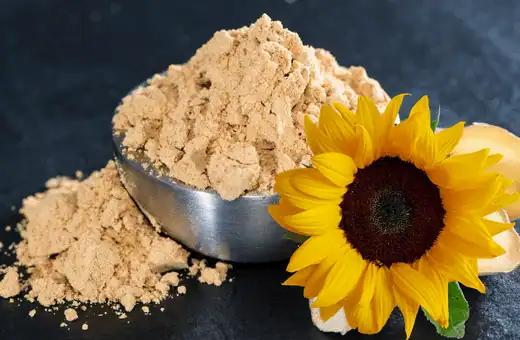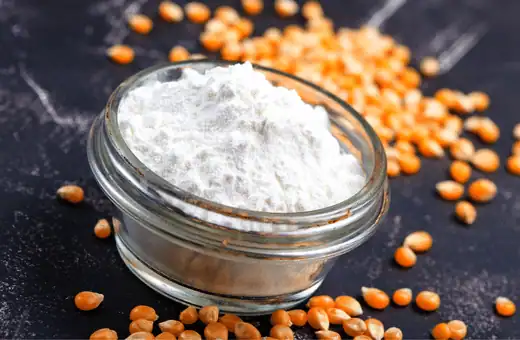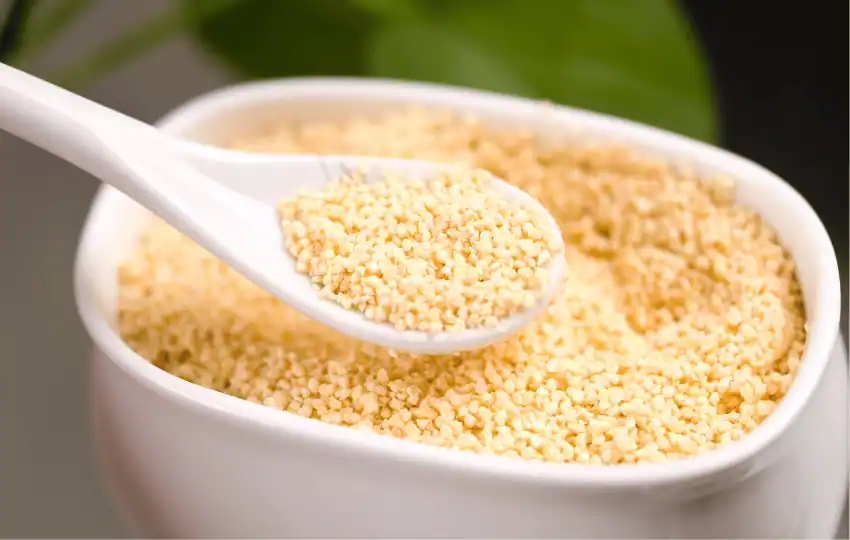So you’re looking for a soy lecithin substitute. You may be allergic to soy, or you just can’t stand the taste.
Whatever the reason, you’re in luck.
In this blog post, we’ll tell you everything you need to know about soy lecithin and why it’s used, as well as some of the best substitutes out there for cooking and baking.
Keep reading to find out more!
What is Soy Lecithin?
Soy lecithin is a yellow-brownish substance that’s extracted from soybean oil.
The reason soy lecithin is used so widely is that it has some amazing properties. For one thing, it’s an emulsifier, which means it helps keep things like water and oil from separating.
It’s also a surfactant, which means it can help reduce the surface tension of liquids (this is why it’s often used in shampoo).
And last but not least, it’s a lubricant, which means it can help prevent sticking and clumping. It can also be used in medicines and even pesticides.
So now that we know what soy lecithin is and why it’s used let’s talk about some substitutes.
Substitutes for Soy Lecithin
There are a few different substitutes for soy lecithin that you can use depending on what you need it for.
Here are some of the most popular substitutes:
1. Sunflower lecithin instead of soy lecithin
Sunflower lecithin is an excellent choice when looking to substitute soy lecithin. It acts as an emulsifier, helping mix together oil and water components in a recipe without spoiling any texture or flavor.
However, it is essential to note that you will need more sunflower lecithin than soy lecithin, as the latter has double the strength of the former.

To get started, I suggest using twice as much sunflower lecithin for every teaspoon of soy lecithin your recipe calls for.
You should consider experimenting with different amounts until you find the desired result!
2. Coconut Lecithin
Coconut lecithin is another popular substitute for soy lecithin. Like sunflower lecithin, it has similar emulsifying properties and can be used in all the same ways.
The main difference is that coconut lecithin has a slightly higher lipid content than soy lecithin, which means it can add a bit more richness to your food products (this might be desirable or undesirable depending on what you’re making).
Read more: Best Coconut flakes substitutes
3. Egg Yolk Lecithin
Egg yolks are an excellent substitute for soy lecithin in certain recipes.
They also have a very strong flavor, so they’re best used in savory dishes rather than sweet ones.
They act as an emulsifier, binding fats and oils together, making them perfect replacements in baking and cooking.
Not only do they possess similar properties to soy lecithin, but they are also full of nutrients and proteins.
Here’s a pro tip – if you need to strengthen your batter, add a few more egg yolks than soy lecithin would be called for.
By doing this simple step, your ingredients will perfectly bind together, resulting in perfectly executed dishes!
4. Vegetable Glycerine
Vegetable glycerine (also called glycerol) is a clear liquid that’s derived from plants. It has excellent emulsifying properties and can be used as a substitute for soy lecithin in most cases.
The only downside is that it doesn’t work well as a surfactant, so it might not be ideal if you’re using it for something like shampoo.
5. I use xanthan gum instead of soy lecithin
If you are an experienced cook, when it comes to baking, you know that sometimes certain ingredients are hard to come by.
Soy Lecithin is one of those tricky ingredients; however, thankfully, xanthan gum is a great substitution.
Xanthan gum has a similar consistency and helps bind recipes and keep them together, much like Soy Lecithin does.
Furthermore, it is completely vegan-friendly, so you can still stick to your dietary choices while creating delicious baked treats!
6. Coconut Oil
If you’re looking for an alternative to soy lecithin as an emulsifier, then look no further than coconut oil.
It’s ideal for homemade food products such as ice cream and mayonnaise, where it’s used to bind together ingredients and help them stay blended.
Coconut oil has a number of other benefits that make it the perfect natural choice; not only does it provide texture and flavor, but it’s also loaded with healthy fatty acids, minerals, and vitamins, making any recipe even healthier.
For those who are conscious about their diets, using coconut oil instead of soy lecithin means that you can avoid unwanted additives while still creating wonderfully tasty dishes.
The only downside is that it can add a coconut flavor to your food.
7. Corn Starch
Corn starch is a good substitute for soy lecithin if you’re looking for something to thicken your food. It doesn’t have the same fatty acid structure, but it can do a good job of mimicking some of the properties of soy lecithin.
Soy lecithin can be used as a food additive to provide some malleability to certain recipes.

However, soy may prove problematic for certain dietary restrictions due to its allergen content. That is why corn starch proves to be a great substitute for those looking for an alternative option.
As a certified expert cook and kitchen veteran, I would highly recommend using corn starch in your favorite recipe calling for soy lecithin – the ingredients blend quite nicely!
From cookies and cakes to puddings and jellies, corn starch is the perfect way to keep those delicious treats vegan-friendly and allergen-free.
How do you make soy lecithin at home?
Making soy lecithin at home is easier than you think! It starts off with a simple trip to the grocery store.
Once you’re back home, all that’s required is to heat some soybeans in a pot of water and then press them through a cheese cloth or sieve.
The lecithin oil that is retained from this method can be bottled up and kept for later use.
As an experienced cook, I’ve found homemade soy lecithin to be much richer in flavor and texture than store-bought alternatives.
For those looking for a higher-quality soy lecithin option, I highly recommend giving it a go yourself!
Wrap up on Soy lecithin substitute
There are many substitutes available for those who want or need to avoid soy products. The best option will depend on what the product will be used for.
In general, sunflower lecithin, coconut lechitinth, and vegetable glycerine are all good substitutes with similar properties to soy lecithin. Keep these options in mind next time you’re looking for an ideal replacement!
FAQs on soy lecithin substitute
Q1. Is soy lecithin the same as regular soy?
Soy lecithin is often confused with regular soy, but they’re actually two very different products.
Regular soy is made from the hulled seeds “soybeans,” while soy lecithin refers to a derivative of the soybean which has been processed and had the oil extracted from it.
Soy lecithin is available in either powder or granular form and is often found as an emulsifier in food products like margarine and salad dressing. Because it’s not allergenic like regular soy, it’s also added to some chocolates and baked goods.
If you’re comparing them for use in cooking, however, you’ll want to stick with regular soybeans – especially if you’re looking for a plant-based protein source!
Q2. Which is better, sunflower or soy lecithin?
Sunflower lecithin is a great choice for those that pay attention to their health and don’t want to sacrifice flavor for low-fat cooking.
It is a naturally occurring fatty substance derived from the shell of sunflower seeds, making it an all-natural and vegan alternative to soy lecithin.
This combination of healthy ingredients helps to reduce cholesterol levels, which in turn helps improve cardiovascular health.
On top of being more natural than soy lecithin, it also has lower emissions of environmental contaminants due to its low crop intensification, which makes it eco-friendly as well.
Our verdict: Sunflower lecithin is better! For a healthier lifestyle, use this great product in your kitchen.

